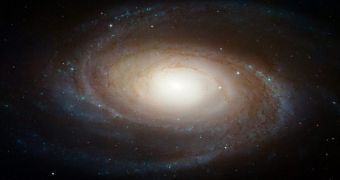A researcher in the United Kingdom is now proposing a new model for explaining how the arms of spiral galaxies are moving around the central bulge. The new view is in direct conflict with existing, widely-accepted theories explaining the same phenomenon.
The proposal is also seeking to explain how spiral arms evolved when the spiral galaxies were still very young. The view is informed by advanced computer models developed by postgraduate student Robert Grand. He is based at the University College London (UCL) Mullard Space Science Laboratory.
Data collected from the simulations also provide a new view on our own galaxy, the Milky Way. This particular cosmic structure is about 100,000 light-years in diameter, and features two spiral arms (though some studies suggest that there may actually be four arms).
The current view explaining the behavior of spiral arms holds that what we perceive as separate structures (the arms themselves) are in fact nothing more than transient structure. They move across a disc of stars that is located around the central galactic bulge.
The most common analogy used to explain this are the waves formed by fans at football games. The wave moves through the crowd, while the people remain in the same positions they were. They don't move with the wave, which makes the latter a transient structure.
What Grand and his colleagues are proposing is that spiral arms are in fact separate structures onto themselves. Individual stars within move in respect to the galactic bulge, and do not maintain the same relative position, Universe Today reports.
Additionally, the new models suggest that the spiral arms break apart and reform once every 80 to 100 million years, under the influences of massive gravitational shear forces. These forces are produced by the spin of the galaxy itself, the UCL team proposes.
“We simulated the evolution of spiral arms for a galaxy with five million stars over a period of 6 billion years. We found that stars are able to migrate much more efficiently than anyone previously thought,” Grand explains.
“The stars are trapped and move along the arm by their gravitational influence, but we think that eventually the arm breaks up due to the shear forces,” the expert goes on to say.
“This research has many potential implications for future observational astronomy, like the European Space Agency’s next corner stone mission, Gaia, which MSSL is also heavily involved in,” he adds.
“As well as helping us understand the evolution of our own galaxy, it may have applications for regions of star formation,” Grand concludes.

 14 DAY TRIAL //
14 DAY TRIAL //